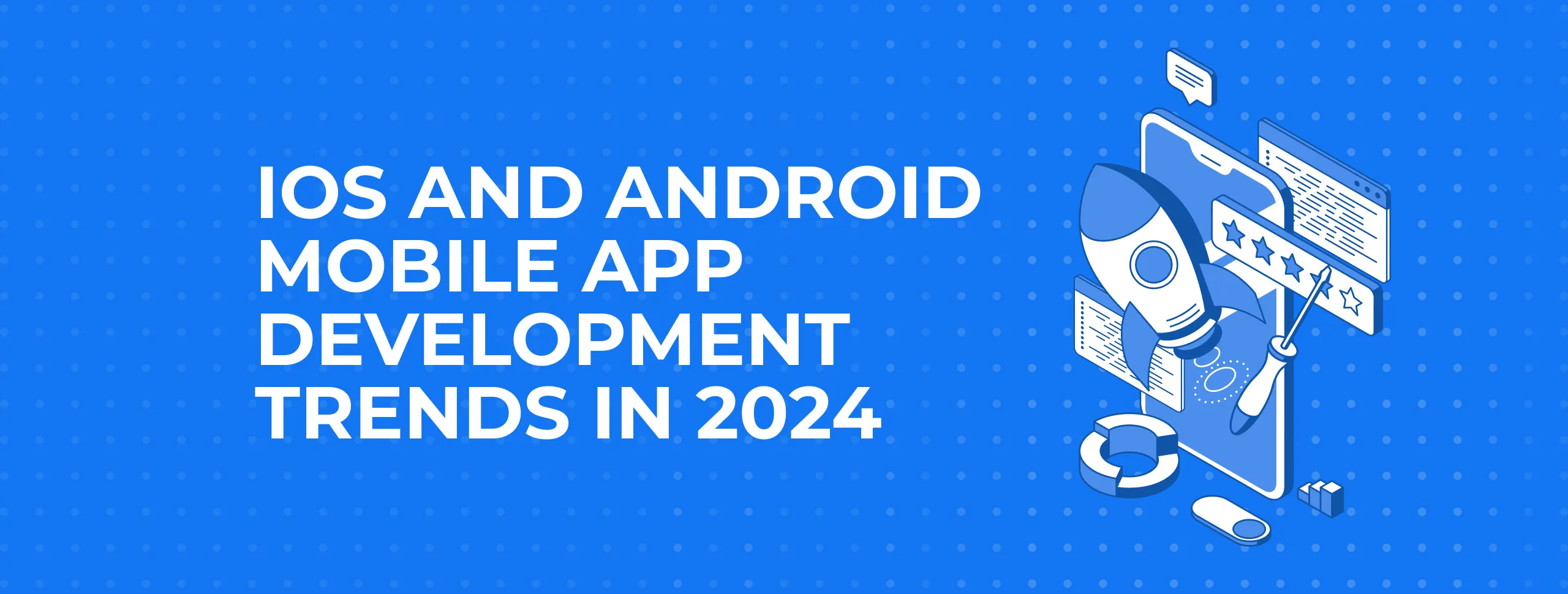
iOS and Android Mobile App Development Trends in 2024

Table of contents
- Introduction
- iOS Native Development Trends in 2024
- Apple’s AR and VR progression
- Apple’s Vision Pro
- Voice User Interfaces
- Wearable Mobile App Development
- The Rise of AI-Powered Apps
- Android Native Development Trends in 2024
- Cross-Platform Development Trends in 2024
- How much does it cost to develop an app in 2024
- Conclusion
Introduction
With the number of smartphone owners expected to climb to almost eight billion by 2028 – at the end of 2022 there were ‘an estimated 6.5 billion smartphone subscriptions’ – there has never been a better time to enlist the services of an app development company or software development company.
The App market’s total revenue is ‘expected to show an annual growth rate (CAGR 2022-2027) of 8.83%, resulting in a projected market volume of $673.80 billion by 2027’ and with ‘total combined Apple App Store and Google Play app downloads [amounting] to an estimated 35 billion’ in the first quarter of 2023 alone, it’s easy to imagine this projection becoming reality.
In 2024, the landscape of iOS and Android mobile app development continues to evolve with a focus on optimising the application development life cycle. Developers and mobile application development services are increasingly emphasising efficient mobile application architecture, a pivotal component in the overall app development life cycle.
This strategic approach ensures a streamlined and effective process, from conceptualization to deployment. As the demand for innovative and user-centric mobile solutions grows, meticulous consideration of the app development life cycle becomes paramount.
Staying abreast of the latest trends involves not only the incorporation of cutting-edge technologies but also a keen understanding of how mobile application architecture and the broader application development life cycle contribute to the success of modern apps on both iOS and Android platforms.
This article explores the key trends, challenges, and innovations in the world of mobile app development for iOS and Android platforms in 2024. We’ll look at how today’s tech market leaders are answering the world’s want to innovate, how a mobile application development company contends with these technological progressions, and what the expected mobile application development cost is.
Let’s first look at Apple.
iOS Native Development Trends in 2024
Swift, Apple’s programming language, ‘is the result of the latest research on programming languages, combined with decades of experience building Apple platforms.’ Apple's recent advancements in Swift have significantly impacted iOS app development, introducing key enhancements that elevate the language's capabilities.
The incorporation of Macros in Swift adds a new dimension of expressiveness and flexibility, allowing Swift developers to create concise and highly readable code with custom functionality. This newfound versatility is complemented by Swift's seamless interoperability with C++, enabling the integration of both languages within the same project and optimising performance-critical operations.
Another noteworthy enhancement by Apple, Result Builders enhance compiler performance for complex types, contributing to a smoother and faster development process. The expanded support for generics in Swift promotes greater type safety and code efficiency, notably improving tasks like JSON encoding/decoding for faster app loading and efficient data processing.
These Swift language improvements have a profound impact on an iOS app developer and iOS app development company. Developers can now create more expressive, concise, and powerful code, enhancing both code maintainability and readability. The performance enhancements, including faster compilation and improved JSON processing, contribute to a streamlined app development experience, potentially reducing overall development time.
The introduction of Macros also paves the way for innovative features and custom tools, expanding the capabilities of iOS apps. Swift's reinforced role in multi-platform projects, facilitated by enhanced C++ interoperability, broadens cross-platform development possibilities, including integration with existing desktop applications. Additionally, the improved type safety provided by enhanced generics acts as a robust shield against runtime errors and code crashes, ensuring overall code reliability.
SwiftUI
In addition to the core Swift enhancements, SwiftUI, a crucial component of custom iOS app development provided by an iOS app development agency or a company that offers iOS app development services, has undergone significant improvements. These include but are not limited to more robust animation tools, simplified data flow with Observable, spatial app builds, and interactive widgets in new locations, collectively enhancing user interfaces with richness and dynamism.
The infusion of new design resources, such as Figma and Sketch templates, additions to SF Symbols, and updated Human Interface Guidelines, empowers developers to craft aesthetically pleasing and consistent app experiences.
More SwiftUI updates can be found here.
Apple’s AR and VR progression
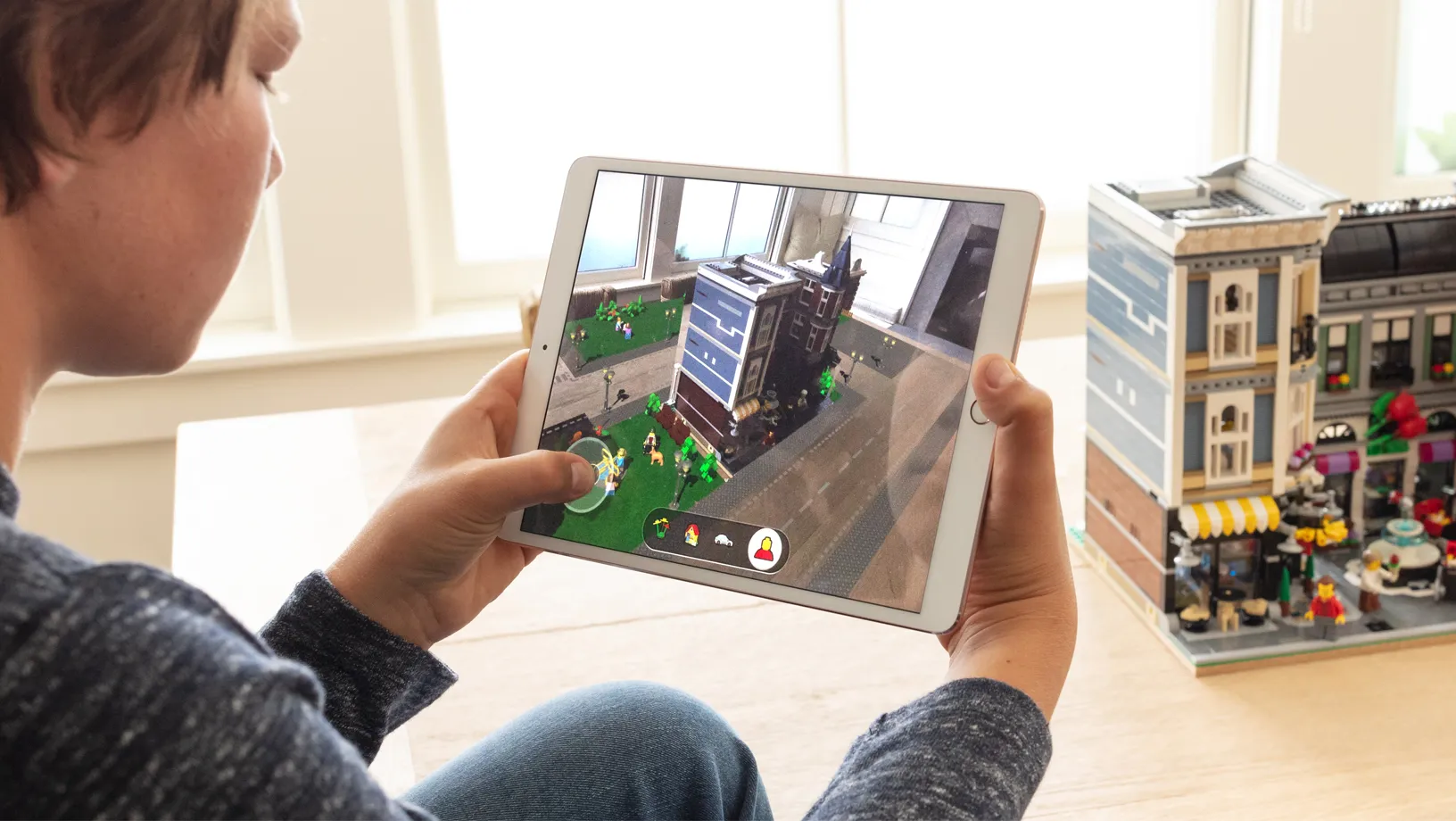
LEGO AR City uses ARKit 2 features including shared experiences, persistent AR and 3D object detection to bring LEGO creations and characters to life. Source: Apple
LEGO AR City uses ARKit 2 features including shared experiences, persistent AR and 3D object detection to bring LEGO creations and characters to life.
‘AR and VR have the ability to transform ordinary mobile apps into extraordinary and immersive experiences.’
Apple continues to make strides in the field of AR and VR development. Launched in 2017, ARKit, a powerful platform that includes accessible augmented reality (AR) creation tools and AR Quick Look – ‘place 3D objects in the real world’ – democratises the ability to bring 3D ideas to life, even for users with minimal prior experience.
With its recent launch of ARKit 6, offering additional features including 4K video, depth API, people occlusion, instant AR, motion capture, simultaneous front and back camera, and scene geometry, ARKit is a source of ongoing investment for Apple.
ARKit's suite of AR creation tools includes:
USDZ Tools
Python-based resources designed for generating, validating, and inspecting USDZ files. Accompanied by sample scripts, the suite leverages Pixar's USD library.
Reality Composer Pro
An easy way to ‘preview and prepare 3D content for your visionOS apps… import and organise assets, such as 3D models, materials, and sounds…available with Xcode.’
.gif)
Reality Converter beta
Use Reality Converter to ‘convert, view, and customise USDZ 3D objects on Mac’ adding your own textures and previewing under various ‘lighting and environment conditions.’
RealityKit (sits alongside ARKit)
RealityKit enables the user to control and customise ‘the AR experiences’ they create. APIs such as ‘custom rendering’ and ‘metal shaders’ gives scope to develop ‘entirely new worlds in AR’ while object capturing ‘using state-of-the-art photogrammetry algorithms’ allows the creation of ‘unique 3D objects.’
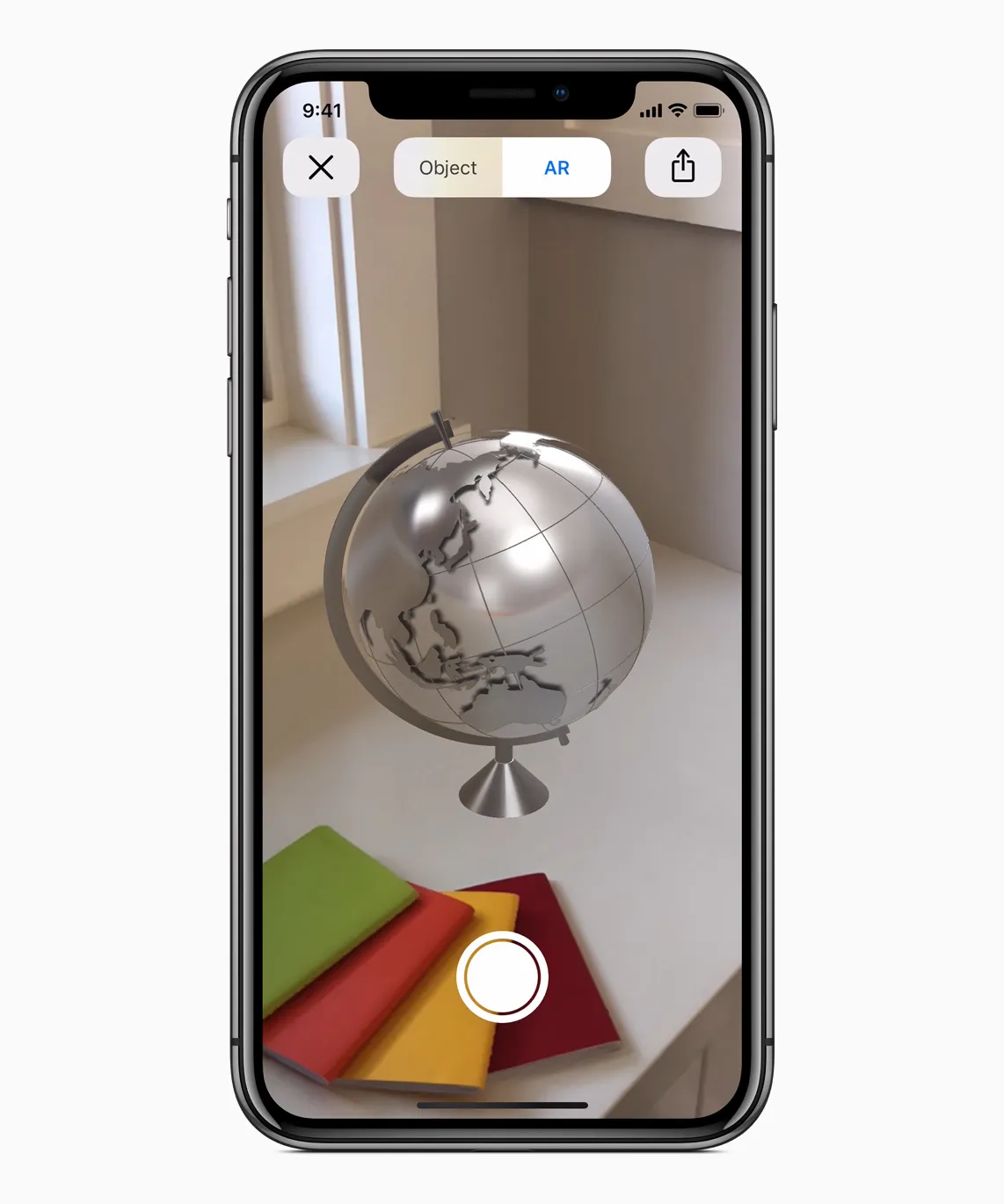
usdz is based on Pixar’s Universal Scene Description and makes it easy to experience AR nearly anywhere in iOS.
Source: Apple
Apple’s Vision Pro
Apple Vision Pro, controlled by the ‘user’s eyes, hands, and voice’, is ‘a revolutionary spatial computer that transforms how people work, collaborate, connect, relive memories, and enjoy entertainment… seamlessly blends digital content with the physical world.’
Set for release on 2 February 2024, the device is ‘Apple's first-ever virtual reality headset’ and comes complete with ‘a 4K display for each eye, allowing users to switch between augmented reality (AR) and virtual reality (VR) with a side-mounted dial.’
Apple Vision Pro operates with Unity, leveraging ‘familiar workflows and powerful tools to build and bring your games and apps into a new frontier of spatial computing.’
Voice User Interfaces (VUIs)
‘Voice feature is one of the most used latest features in mobile apps. It is more relevant and will be the centre of source for the apps.’
Increasingly ‘common in our daily lives as a result of the growth of voice-activated virtual assistants such as Siri and Alexa’ VUIs ‘enable users to engage with devices by speaking to them, making technology more accessible and convenient.’
Allowing ‘consumers to communicate with technology through natural language’, VUIs can perform a multitude of tasks from answering questions and creating reminders to operating smart home devices.’
The technology is transforming the way we interact; however, challenges are noted, with users concerned about ‘interactions being captured’ and developers acutely aware that various accents, speech patterns and background noise can hinder the app’s ability to interpret commands.
Wearable Mobile App Development
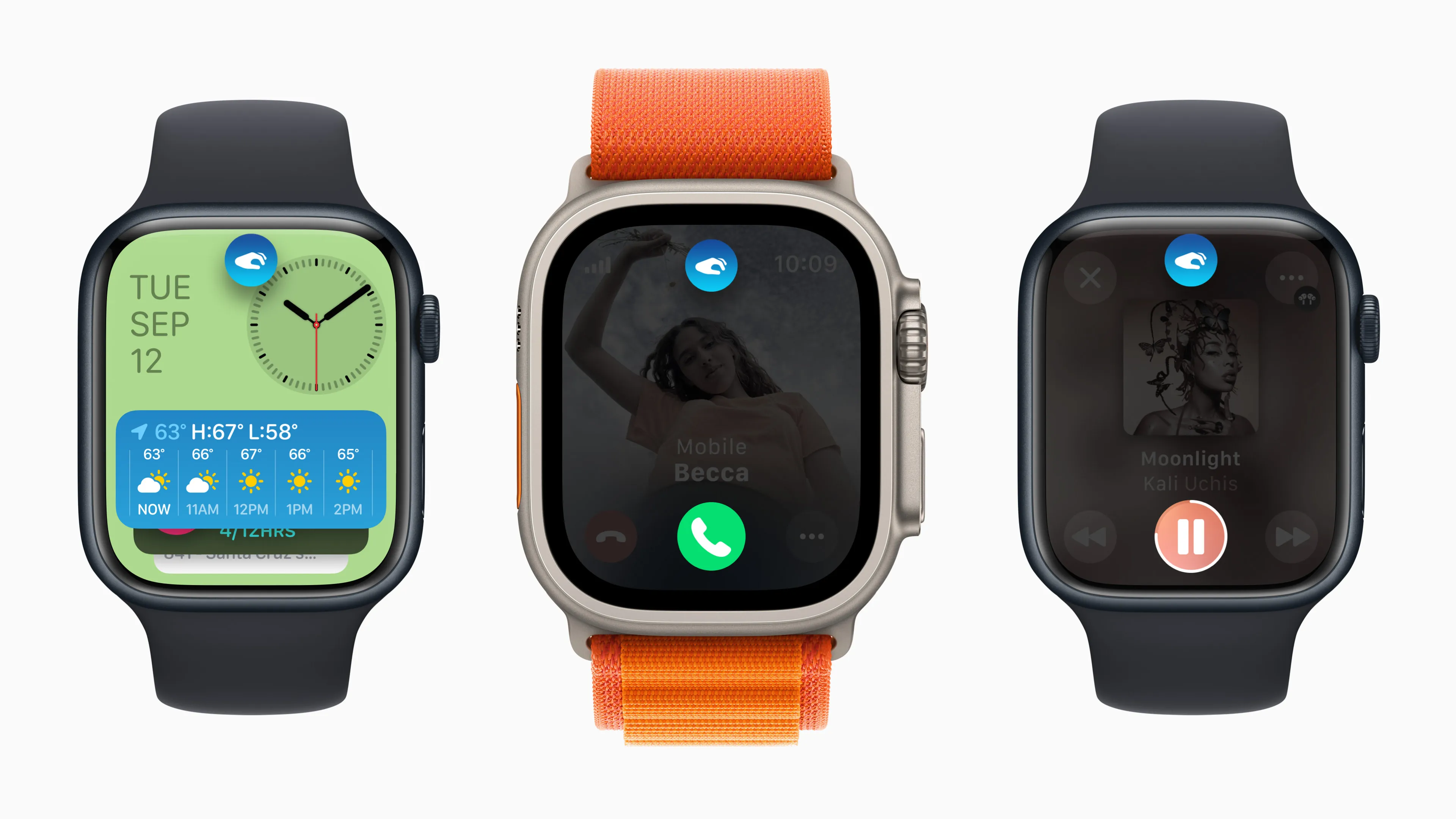
Apple Watch. Source: Apple
The wearables market is projected to grow to USD 380.5 billion by 2028.
watchOS has announced its ‘biggest update since the introduction of Apple Watch.’ The update promises a ‘fresh’ app look, ‘new ways to navigate’, and ‘a new Smart Stack to display the information you need’.
Furthermore, five software updates have been released:
Note: descriptions copied verbatim from source.
- Access and log Health app data with Siri
- Automatically view Now Playing when in proximity of HomePod (2nd generation) or HomePod mini playing media from Music or Podcasts
- Swipe to change watch faces in Settings
- Confirm ending workouts in Settings
- Prioritise the volume of either the music or trainers’ voices in most Fitness+ workouts
The Rise of AI-Powered Apps
AI-powered apps are fundamentally altering how we engage with technology. Transforming our daily lives, these applications leverage artificial intelligence to perform tasks, analyse data, and tailor experiences through personalised content, recommendations, and adaptive functionality in unprecedented ways.
Virtual assistants now manage tasks like booking appointments, scheduling meetings, and handling finances, while AI analyses medical data for early disease detection, creates personalised treatment plans, and facilitates virtual consultations in the healthcare sector.
There are many examples of AI shaping our interactions and progressing our industries. Read more on this topic here.
Android Native Development Trends in 2024
Like iOS, Android app development in 2024 is shaped by innovation. Foldable screens blur the lines between phone and tablet, while AI personalises experiences and automates tasks. The key trends driving this mobile app frontier provide opportunities for developers to push boundaries and captivate users.
Kotlin’s Ascent
Java, the once-dominant language for an Android app development company or provider of Android app development services, has made way for Kotlin: the more efficient way to develop an android app.
The conciseness and expressiveness of Kotlin significantly enhance Android app developer productivity, while Kotlin Multiplatform provides cross-platform code compatibility, empowering developers to craft applications for diverse platforms using a single codebase: 'the Kotlin Multiplatform technology is designed to simplify the development of cross-platform projects. It reduces time spent writing and maintaining the same code for different platforms while retaining the flexibility and benefits of native programming.'
The latest updates from Kotlin include:
- New default hierarchy template for setting up multiplatform projects
- Full support for the Gradle configuration cache in Kotlin Multiplatform
- Custom memory allocator enabled by default in Kotlin/Native
- Performance improvements for the garbage collector in Kotlin/Native
- New and renamed targets in Kotlin/Wasm
- Support for the WASI API in the standard library for Kotlin/Wasm
- Amper, ‘a tool to improve the project configuration user experience. It offers concise, declarative configuration with sensible defaults for common use cases and carefully considered extension points.’
Foldable and dual-screen devices
Foldable and dual-screen devices are providing developers with unique opportunities to reimagine app design and user experience.
Google Pixel has promised two new Android devices, ‘with improved tools and guidance like the new Pixel Fold and Pixel Tablet emulator configurations in Android Studio Hedgehog Canary 3, expanded Material design updates, and inspiration for gaming and creativity apps.’
Pushing the boundaries of app design, foldable and dual-screen devices present unique challenges and opportunities. Here are the key areas:
Responsive Layouts
While the prospect of designing to suit foldable and dual-screen devices is exciting, it’s not without its challenges. The ‘seamless experience’ that users expect from mobile apps across all devices must carry across to new ‘viewing modes’ (split view, freeform view etc.)’ increasing ‘variables even more’ for designers and developers.
Optimising Performance
With ‘foldable devices often [having] unique hardware configurations’, developers must optimise mobile apps ‘for the specific capabilities of each device. This may include taking advantage of the larger screens for multitasking or providing enhanced graphics and animations.’
Multi-Window Optimisation
The introduction of dual-screen devices, such as the Microsoft Surface Duo, has opened up exciting possibilities for multitasking. Now that users can effortlessly view content side-by-side, developers can design applications that take full advantage of dual displays, execute seamless drag-and-drop actions between screens, and launch distinct applications on each panel.
Content Continuity
Folding screens provide an opportunity to showcase inventive features such as split video playback, expansive maps that extend seamlessly across panels, and the presentation of the main content on the large screen with related information on the smaller one.
The latest in Material Design
Material Design, Google's comprehensive design system, announced its latest version Material 3 (M3) in 2021 which has since undergone several updates.
The latest updates include:
- The launch of a complementary design kit complete with a ‘library of ready-made components’ for use with Figma
- M3 for Jetpack Compose
- The M3 carousel: new component
- New motion and gesture capabilities for smooth navigation across screens
- Motion system updates
- Material theme builder: the M3 colour system and dynamic colour
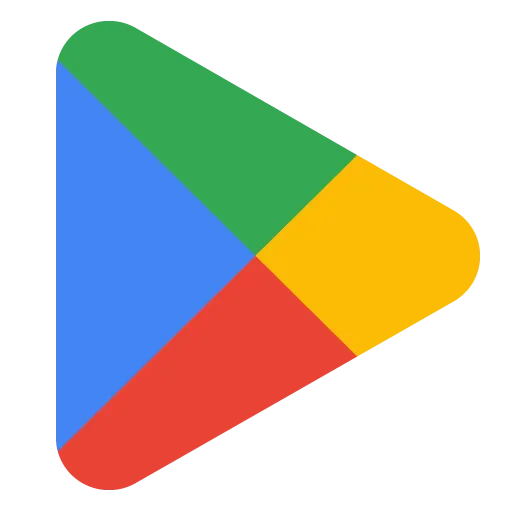
Google Play icon. Source: Google
Google Play Instant apps
Available ‘to all app and game developers’ Google Play Instant apps break with tradition.
This platform enables the user to ‘use an app or game without installing it first’ meaning developers can ‘increase engagement’ and ‘gain more installs by surfacing [their] instant app across the Play Store and Google Play Games app.’
Simplifying things further still, ‘Android’s new app publishing format, the Android App Bundle’ lets users ‘build and publish one app bundle artifact to Google Play containing both instant and feature modules’ and ‘build instant games easily with Cocos and Unity plug-ins’.
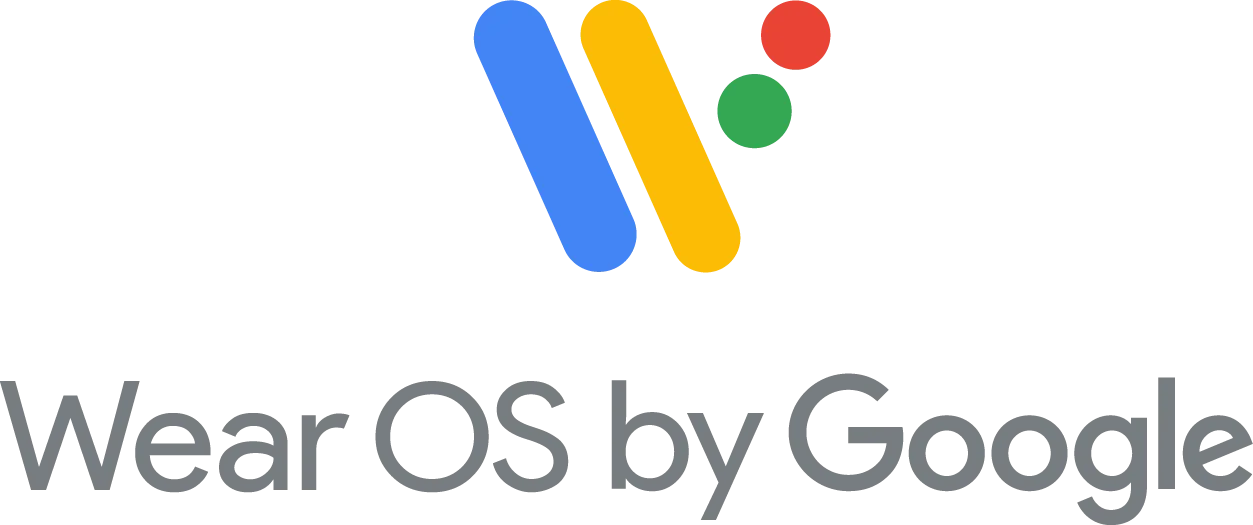
Source: Google
Wearables: Android Wear Updates
Akin to the Apple Watch, Wear OS by Google transports the capabilities of your phone to your wrist.
From optimised workouts, music, and health updates to ‘directions, search, payments and more’ Android links several apps to your device so you can do more with less.
The latest updates include:
- WhatsApp for Wear OS
- Spotify tiles: ‘let Spotify's DJ deliver a personalised lineup of your favourite music, stream episodes of your favourite podcasts and listen to what's in your heavy rotation.’
- New Watch Face Format: ‘XML format built in partnership with Samsung.’
![]()
Google Pixel Watch. Source: Google
ARCore Updates
Like Apple, Google is making strides in the world of AR and VR.
Google’s platform, ARCore promises to ‘make the world your canvas’, allowing developers to ‘create world scale immersive experiences in over 100 countries using the largest cross-device augmented reality platform’ complete with ‘easy to integrate workflows’ and the brand’s ‘learned understanding of the world through Google Maps.’
The latest updates include:
Note: descriptions copied verbatim from source.
Streetscape Geometry API
Interact, visualise, and transform building geometry around the user.
Rooftop Anchors
Anchor digital content securely to building rooftops, respecting the building geometry and the height of buildings.
Geospatial Depth
Combines the mobile device's real-time depth measurement with Streetscape Geometry data to improve depth measurements using building and terrain data providing depth for up to 65m.
Scene Semantics API
Provide a class label to every pixel in an outdoor scene, so you can create custom AR experiences based on the features in an area around your user.
Mega Golf
The game that brings augmented mini-golf to your neighbourhood.
The ‘Gemini era’
Multimodal ‘from the ground up’ Gemini AI, Google Deepmind’s ‘most capable AI model’, as Sundar Pichai, CEO of Google and Alphabet, explains, ‘can seamlessly have a conversation across modalities…and understand the world around us in the way that we do’ absorbing ‘any type of input and output’ including code, audio, image and video, ‘not just text like most models.’
This is ‘the first model to outperform human experts on MMLU (Massive Multitask Language Understanding), one of the most popular methods to test the knowledge and problem-solving abilities of AI models’ and ‘surpasses state-of-the-art performance on a range of multimodal benchmarks’ – Google welcomes its users to ‘the Gemini era’ and it may not be wrong. This advanced AI is set to revolutionise what is possible in web and mobile app development.
Cross-Platform Development Trends in 2024
Cross-platform development is experiencing a surge in popularity, with developers increasingly opting for frameworks that enable app creation for multiple platforms using a single codebase. This approach not only saves time and resources but also facilitates reaching a broader audience quickly.
Let’s take a closer look at popular trends in cross-platform development for 2024.
Flutter
Flutter has experienced a surge in popularity, establishing itself as a prominent cross-platform framework on a global scale. Renowned companies such as Google, BMW, and Tencent have embraced Flutter as their preferred choice for app development.
One of Flutter's standout features is its Hot Reload capability, accelerating development by enabling instant code changes directly on the device.
Embracing a "write once, run anywhere" philosophy, Flutter promotes extensive code reusability across various platforms, leading to substantial reductions in development time and effort. Noteworthy for delivering native-like performance and seamless animations, Flutter's rendering engine has contributed significantly to the acclaim received by Flutter-powered applications.
React Native
React Native is in a constant state of evolution, effectively closing the divide between native and cross-platform development.
Recent introductions like the Fabric feature have elevated the development of applications, giving them an authentic native appearance and performance.
With a vibrant and engaged community, the framework offers developers access to an extensive collection of libraries, components, and tutorials. The React Native team's commitment to ongoing innovation solidifies its status as a leading-edge platform for cross-platform app development.
Kotlin Multiplatform
Kotlin Multiplatform has seen significant updates, making it an even more attractive choice for your next app project. Enhanced IDE support in IntelliJ IDEA and Android Studio now offers better code completion, refactoring tools, and debugging capabilities, streamlining the development process.
The new Kotlin K2 compiler reduces build times and boosts performance, enhancing the developer experience. Improved library support ensures compatibility with popular tools like Ktor for networking, SQLDelight for database operations, and Serialization for data handling.
With updates to Kotlin's coroutines, managing concurrency in Multiplatform projects has become easier, ensuring smooth and efficient app performance across all target platforms. Kotlin Multiplatform now supports more platforms, including Windows, Linux, and WebAssembly, in addition to iOS, Android, JVM, and JavaScript.
Better Gradle integration simplifies the build process and dependency management, making it easier to handle complex projects. Expanded documentation and community resources provide comprehensive guides, tutorials, and an active forum for support.
These updates make Kotlin Multiplatform a robust and versatile option for developing efficient, high-performance applications that run seamlessly across various devices and operating systems.
Progressive Web Apps (PWAs)
PWAs replicate the functionality of native apps while maintaining a lightweight and easily accessible profile. Their distinctive benefit comes from not mandating installation via an app store, enhancing user-friendliness, especially for individuals with restricted storage or data plans.
The offline capabilities of PWAs stand out as a significant advantage, catering to scenarios with unreliable or no connectivity. Additionally, PWAs seamlessly integrate app-like features such as push notifications, geolocation, and camera access, providing a compelling alternative for a diverse range of applications.
Low-Code and No-Code Solutions
Low-code and no-code platforms are transforming the landscape of app development, breaking down barriers and empowering individuals of all coding proficiency levels to create apps. Utilising intuitive visual drag-and-drop interfaces and pre-built components, these platforms accelerate the app development journey.
For developers, these solutions serve as a streamlined pathway, freeing them to concentrate on intricate elements such as business logic and backend integrations. With their inclusive approach, low-code and no-code platforms make app development accessible to a broader audience, fostering a culture of innovation and creativity.
As technology advances, further innovations in this space can be expected, promising an even more streamlined and rapid app development experience.
Performance Considerations
There is an ongoing debate between mobile application developers over performance differences between native and cross-platform solutions, namely how developers are addressing these challenges and what are the best practices for developing mobile applications.
Considerations include performance optimisation, code reusability, and development efficiency. Native development, leveraging platform-specific tools, ensures optimised performance but demands separate codebases for iOS and Android, potentially elongating development timelines. On the other hand, cross-platform frameworks like React Native and Flutter prioritise development streamlining through code reusability, minimising time-to-market. However, concerns persist regarding potential performance issues, especially in graphics-intensive applications.
To navigate these challenges, developers are increasingly adopting hybrid approaches that amalgamate native and cross-platform elements. Techniques such as code splitting and lazy loading are employed to optimise performance, while ongoing updates to cross-platform frameworks aim to bolster overall functionality. The selection of the appropriate framework, tailored to project requirements, is paramount; Flutter may be favoured for UI performance, while React Native gains traction for its robust community support.
In parallel, developers are proactively investing time in continuous learning, staying abreast of the latest advancements in mobile development technologies. As both native and cross-platform methodologies advance, the anticipated narrowing of the performance gap underscores the pragmatic approach adopted by developers. The decision-making process involves a meticulous assessment of each project's specific needs in relation to the advantages and challenges presented by native and cross-platform development.
User experience consistency
To ensure a consistent and seamless user experience across different platforms, crucial for enhancing user satisfaction and maintaining a strong brand presence across diverse devices, several strategies are being employed by developers.
Here are some of them:
Responsive Design
Developers are prioritising responsive design principles, ensuring that the web and mobile app's User Interface (UI) adapts to different screen sizes and resolutions.
Platform-specific UI guidelines
Adhering to platform-specific design guidelines, such as Apple's Human Interface Guidelines for iOS and Google's Material Design for Android, ensures that the app's UI aligns with the expectations of users on each platform. This helps in creating a native-like experience.
Cross-platform app development frameworks
Leveraging cross platform mobile app development frameworks like React Native, Flutter, or Xamarin to write code that can be reused across iOS and Android means that the development process can be streamlined while ensuring a consistent experience by adapting to platform-specific nuances. The best cross platform app development considers all possibilities.
Cross-platform mobile app development vs. native
The decision between cross-platform and native mobile app development centres on a trade-off. Cross-platform frameworks like React Native and Flutter enable faster development through code reuse but concerns about performance may arise. Native development ensures optimal performance with platform-specific tools but requires separate codebases.
The choice boils down to balancing the efficiency of cross-platform development with the performance advantages of native development, considering project needs, team skills, and long-term maintenance.
Platform-specific customisation
Platform-specific customisations can be incorporated while utilising cross-platform frameworks, taking advantage of unique features or design patterns on iOS and Android, ensuring a more tailored experience for users on each platform.
Thorough testing across devices
Essential to identifying and addressing any platform-specific issues, developers are embarking on rigorous testing across a diverse range of iOS and Android devices, screen sizes, resolutions, and operating system versions to ensure a seamless experience for all users.
Security and Compliance
‘According to a recent study by Cisco, 32% of adults have switched companies or service providers based on their data or data-sharing policies.’
The landscape of mobile app security and compliance standards in iOS and Android development is continually evolving, necessitating a keen focus on adherence to guidelines on both iOS and Android platforms.
Upholding user privacy and data protection is paramount, requiring developers to implement robust measures such as encryption, secure data storage, and transparent user consent mechanisms, while App Store guidelines must be rigorously followed to ensure successful deployment and avoid the consequences of app rejection or removal, which could adversely affect an app's reputation.
Regular security audits, testing, and adherence to legal regulations, including GDPR, contribute to a holistic approach to app security. Likewise, using secure communication protocols, obtaining explicit user consent for app permissions, and practicing secure coding techniques are fundamental steps to safeguarding mobile applications against common vulnerabilities.
Read more on this topic, including biometric integration, here.
With all this in mind, how do you choose the right framework for your future mobile app?
Choosing your framework
A critical decision that profoundly influences the efficiency and success of your project, first you must assess your project's requirements, considering factors such as complexity and the need for platform-specific features.
When prioritising speed in app development, cross-platform frameworks like React Native and Flutter offer advantages such as code reuse and accelerated coding. Consideration of your app's UI requirements is crucial, ensuring seamless integration with platform-specific design components.
Assessing the framework's learning curve is essential, ensuring alignment with your team's existing skills or manageable adaptation. While native development traditionally ensures optimal performance, certain cross-platform frameworks, like Flutter, impress with their ability to compile to native code.
Evaluate flexibility, extensibility, and the capability to integrate third-party tools to meet evolving requirements. Opt for actively maintained frameworks with clear development roadmaps for long-term maintenance. Ultimately, the right framework selection is instrumental in building a successful and sustainable mobile app.

How much does it cost to develop an app in 2024?
The cost of developing an app can vary ‘depending on the complexity, features and target platforms.’
App development in the UK vs. the USA
When sourcing mobile app developers in the UK it is good to have a price comparison.
How do app development costs vary between the UK and the US?
A top app developer in the UK may charge anywhere from £30,000-£60,000, while in the US, the average cost of developing an app can range from US $60,000 to $250,000.’ Generally speaking, an app development agency in the UK is cheaper than one you might find in the US of a similar standard.
The same applies to developing apps for Android in the UK and developing apps for iOS in the UK compared to the US.
App development cost in the UK: sliding scale
To illustrate app development costs and what you might expect to pay, we’ve drawn up a handy sliding scale.
.webp)
Conclusion
The year 2024 marks a dynamic and innovative era for iOS and Android mobile app development, fuelled by the expanding global smartphone user base and the growing importance of mobile applications. With ‘an estimated 6.5 billion smartphone subscriptions’ owned at the end of 2022, expected to climb to almost eight billion by 2028, the demand for innovative mobile solutions is at an all-time high.





